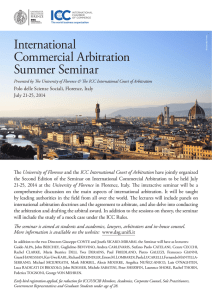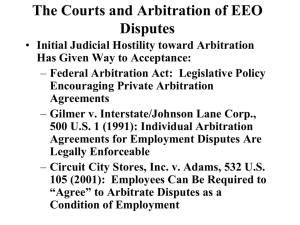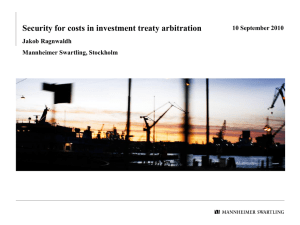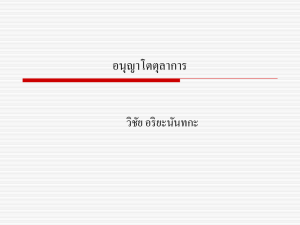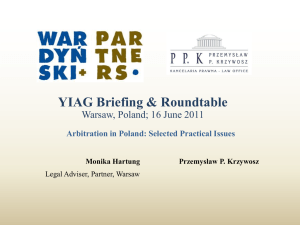Dr.ssa Alessia Vanni The aim of the present research is to study the
advertisement
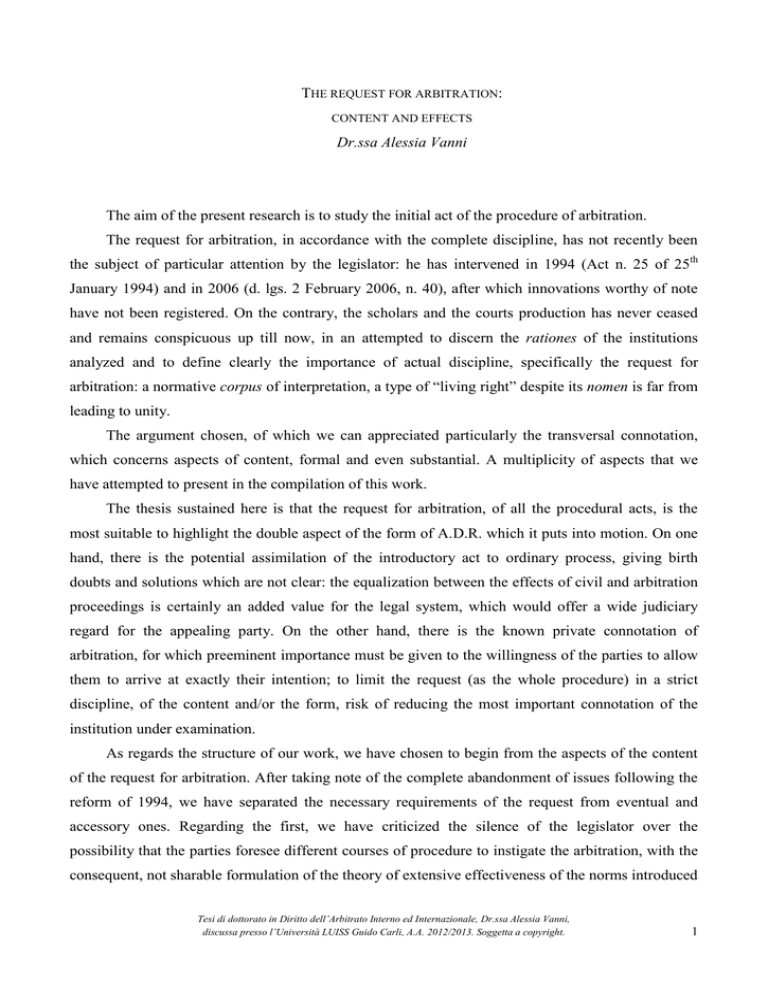
THE REQUEST FOR ARBITRATION: CONTENT AND EFFECTS Dr.ssa Alessia Vanni The aim of the present research is to study the initial act of the procedure of arbitration. The request for arbitration, in accordance with the complete discipline, has not recently been the subject of particular attention by the legislator: he has intervened in 1994 (Act n. 25 of 25th January 1994) and in 2006 (d. lgs. 2 February 2006, n. 40), after which innovations worthy of note have not been registered. On the contrary, the scholars and the courts production has never ceased and remains conspicuous up till now, in an attempted to discern the rationes of the institutions analyzed and to define clearly the importance of actual discipline, specifically the request for arbitration: a normative corpus of interpretation, a type of “living right” despite its nomen is far from leading to unity. The argument chosen, of which we can appreciated particularly the transversal connotation, which concerns aspects of content, formal and even substantial. A multiplicity of aspects that we have attempted to present in the compilation of this work. The thesis sustained here is that the request for arbitration, of all the procedural acts, is the most suitable to highlight the double aspect of the form of A.D.R. which it puts into motion. On one hand, there is the potential assimilation of the introductory act to ordinary process, giving birth doubts and solutions which are not clear: the equalization between the effects of civil and arbitration proceedings is certainly an added value for the legal system, which would offer a wide judiciary regard for the appealing party. On the other hand, there is the known private connotation of arbitration, for which preeminent importance must be given to the willingness of the parties to allow them to arrive at exactly their intention; to limit the request (as the whole procedure) in a strict discipline, of the content and/or the form, risk of reducing the most important connotation of the institution under examination. As regards the structure of our work, we have chosen to begin from the aspects of the content of the request for arbitration. After taking note of the complete abandonment of issues following the reform of 1994, we have separated the necessary requirements of the request from eventual and accessory ones. Regarding the first, we have criticized the silence of the legislator over the possibility that the parties foresee different courses of procedure to instigate the arbitration, with the consequent, not sharable formulation of the theory of extensive effectiveness of the norms introduced Tesi di dottorato in Diritto dell’Arbitrato Interno ed Internazionale, Dr.ssa Alessia Vanni, discussa presso l’Università LUISS Guido Carli, A.A. 2012/2013. Soggetta a copyright. 1 Abstract by the reform; while, leaving space for the will of the contendants, who could well foresee different means of introductions from those legislative. We have also considered the juridical consequences that derive from omission, either total or partial, concluding that the lack of one said requirement does not always lead to reduced effectiveness of the act, as the missing requirement could be integrated later or deduced implicitly; vice versa, the missing indication of the object of the claim can only lead to the invalidity of the request. With reference to accessory requirements, we have highlighted how, in the norm ad hoc, the legislator has completely ignored some typically disciplinary requirements of art. 163 c.p.c., among which the signature of the party (or defender) and the letter of attorney. We have then turned our attention to the effects that stand from the introduction of arbitral proceeding, through a separation between the substantial effects and the procedural ones. With regard to the former, with the coming into force of the 1994 reform they are pacifically recognizable in the request that present the requirements indicated therein (the said “qualified request”), but not where the parties have attributed content and forms different by those suggested by the legislator, the interruptive effectiveness (immediate and permanent) of the prescription, the efficacy proper of transcription to anticipate the effects of the arbitration award and the ability to maintain the effectiveness of the ante causam precautionary measures. The request for arbitration, if still in time, could impede a forfeiture, reduce the effects of bona fides of possessor and fix the dies a quo for anatocistic interests, in accordance with judicial request. Decidedly more controversial and in continue development is the acknowledgement of the procedural effect of the request for arbitration, which today is the center of attention of the highest level of the judiciary. Returning to the order of treatment, we can affirm that the pendency (with its widest meaning, i.e. as the moment of the beginning of the procedure) is an imperative effect in the an, but not in quomodo; this must refer to the moment when the claimant has done all he should and could to promote the arbitral procedure, bearing in mind the different forms to initiated foreseen in the arbitration ad hoc, in the administrated one or chosen by the parties. With regard to pendency in the strict sense and continence, the conflict among the proceedings pending and which coincide totally or partially can be recomposed no longer through the criterion of prevention, but through the system of the parallel paths (ex art. 819 ter, comma I, c.p.c.), which has definitively substituted the model of vis attractiva without solving ab imis the problem in consideration. It appears to move it from the initial fase to final fase of the procedure, forcing the interpreter to evaluate, not the precedence between the notification of the two requests, but the conflict between the respective awards. Tesi di dottorato in Diritto dell’Arbitrato Interno ed Internazionale, Dr.ssa Alessia Vanni, discussa presso l’Università LUISS Guido Carli, A.A. 2012/2013. Soggetta a copyright. 2 Abstract The themes of pendency, continence and connection have been also analyzed distinguishing the various hypothesis of contemporary pendency of various proceedings on the base of the subject called to judge them: excluding the applicability of the general normative of the code of civil procedure between judges and arbitrators, a larger opening has been noticed in the hypothesis of simultaneus processus before arbitrators, above all there is contemporary pendency of the same controversy before the same arbitrators. Regarding perpetuatio iurisdictionis, we feeled obliged to give preeminence to the concrete profile of the function exercised by the arbitrators, that is jurisdictionary in concrete (in the sense of public interest about the protection of subjective juridical situations): so, there is no impediment to the application of art. 5 c.p.c. to the relationship between arbitrators and judge, either in the light of economy of the process or attributing relevance with the aim of conserving the effects produced by an act by a party done legitimately on the base of the norm in act at the moment of the introduction of procedure. To conclude, we have examined the institution of translatio iudicii, which until some months ago was outside the operating field of the arbitration and which today, finally, has been admitted by the Constitutional Court advocating the fundamental rights of equality, defense and legitimate expectations of the party for a fair trial. However, we have expressed our doubts on the direct application of art. 50 c.p.c. on relationship between arbitrator and judges, which at the most could inspire a different legislative discipline, which is still needed and which takes into account the peculiarity of the form of A.D.R. under discussion. Thus it is suggested that it may be sufficient to establish the arbitral procedure ad quem according to the terms of art. 50 c.p.c. or by the transmissing judge and with the conditions accorded in the agreement, which, however, is not able to prescind from the transmission of the introductive act to the juridical sphere of the counterpart, thus obtaining the maximum respect (in the terms) of the agreement and at the same time the maximum protection (in the form) of the will of the parties. The final part of the treatise is dedicated to the formal procedure for an arbitration proposal, the analysis of which is not complete with the examination of the meagre provisions of the code of civil procedure. The arbitration, in fact, lays out its power at the best where due space to the will of the parties is granted: the possibility of adapting the modus procedendi to their specific requirements must be recognized, not only theoretically. From the various formal aspects we have dedicated particular attention to the notification, in the attempt to identify the equivalent forms and the effects that follow these, which highlight the analogies and differences with respect to the ritual arbitration. We have also faced the theme of the new forms of notification introduced for civil proceeding, i.e. Tesi di dottorato in Diritto dell’Arbitrato Interno ed Internazionale, Dr.ssa Alessia Vanni, discussa presso l’Università LUISS Guido Carli, A.A. 2012/2013. Soggetta a copyright. 3 Abstract the notification of the lawyer itself and the transmission by means of PEC, evaluating (positively) the possibility of its application to ritual arbitration in an extensive way. This is a problem which, at the birth of a full digitalization of civil proceeding, has a taste of actuality more than ever today. As regards the method, we have considered the opportunity of not limiting ourselves to the state of the discipline in force: thus every individual theme is accompanied by wide references to the scholars and the courts (both in favor and against the convictions of the author) and faced with a look at the past, present and future. For some institutions we have also prospected a reading in a comparative sense, where the objects of comparison have often been ordinary process, sometimes foreign regulations, at other times the species of arbitration which are an alternative to the ritual one, i.e. administered and company arbitration. Finally, we have attempted, were possible, to place the problems in the general rule as they presented themselves, in view of the possible final solution. Tesi di dottorato in Diritto dell’Arbitrato Interno ed Internazionale, Dr.ssa Alessia Vanni, discussa presso l’Università LUISS Guido Carli, A.A. 2012/2013. Soggetta a copyright. 4

